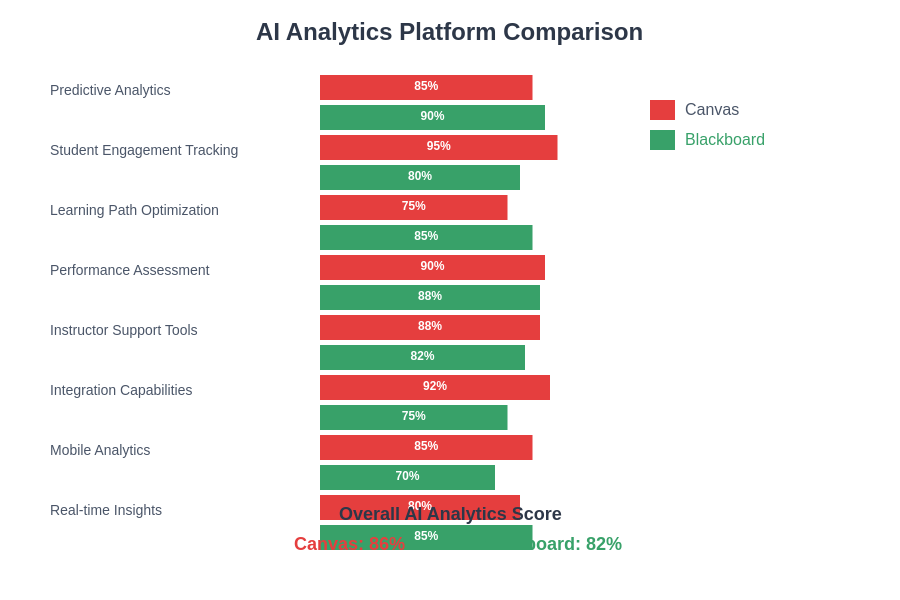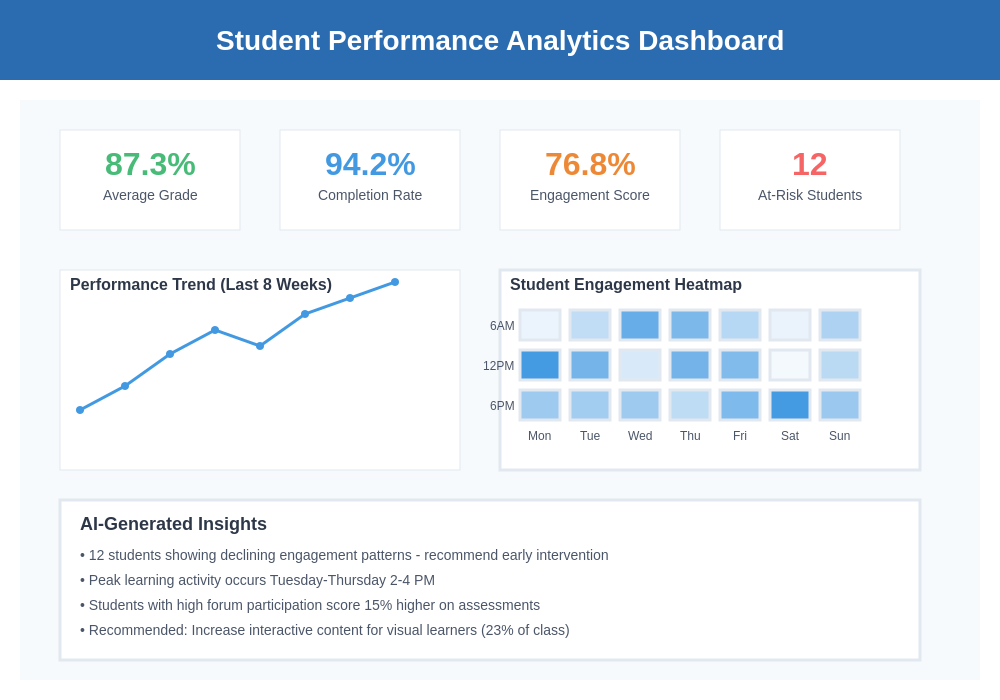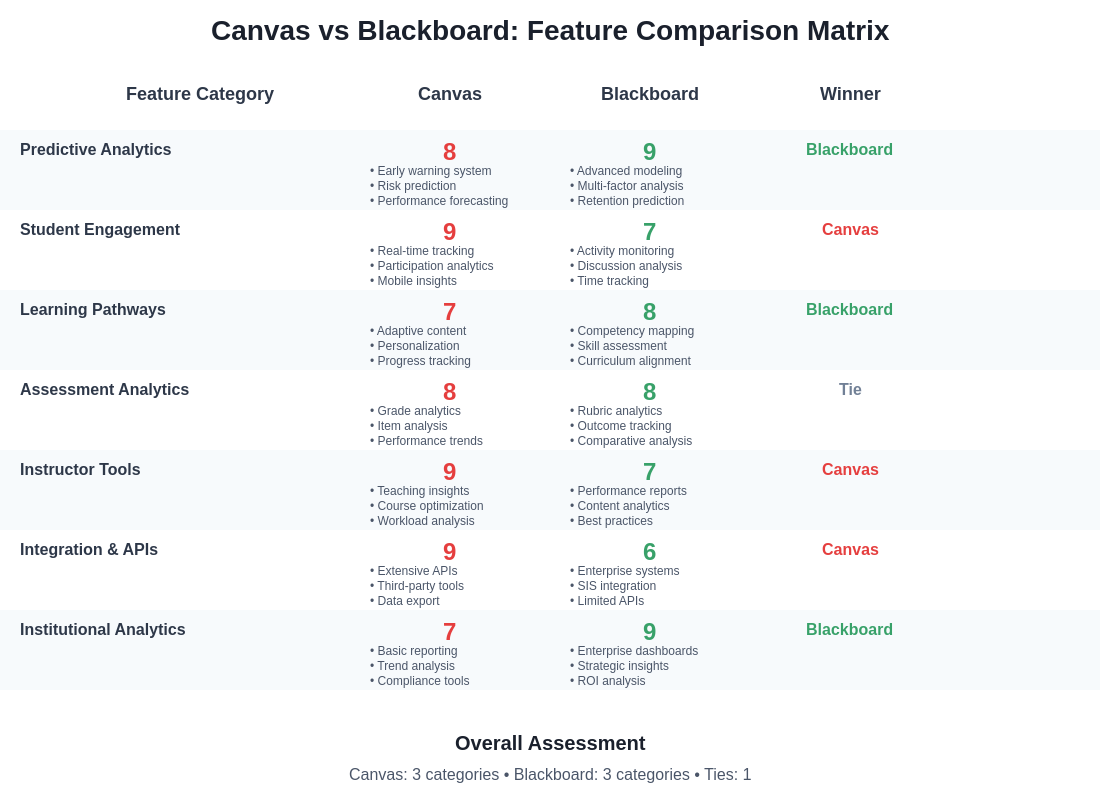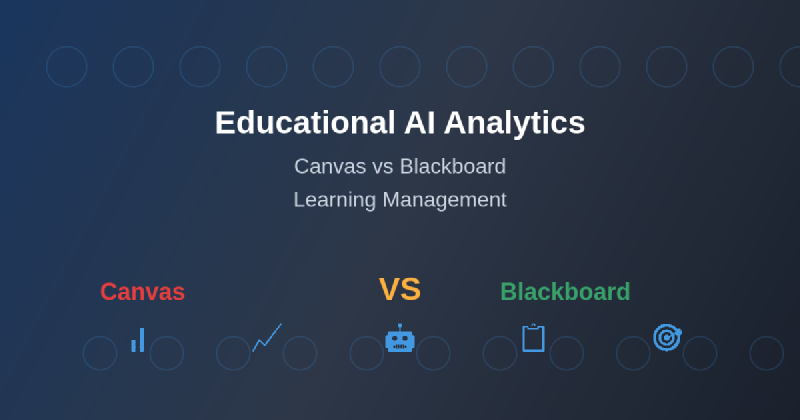The educational technology landscape has undergone a revolutionary transformation with the integration of artificial intelligence into learning management systems, fundamentally changing how institutions track, analyze, and optimize student learning experiences. Among the leading platforms in this space, Canvas and Blackboard have emerged as dominant forces, each offering sophisticated AI-powered analytics capabilities that promise to unlock new insights into student performance, engagement patterns, and educational effectiveness.
Explore the latest trends in educational AI technology to understand how artificial intelligence is reshaping the future of learning and student success initiatives. The evolution of learning management systems from simple content repositories to intelligent analytics platforms represents one of the most significant advances in educational technology, providing educators and administrators with unprecedented visibility into the learning process.
The competition between Canvas and Blackboard in the AI analytics space reflects broader trends in educational technology, where data-driven decision making has become essential for improving student outcomes and institutional effectiveness. Both platforms have invested heavily in developing sophisticated algorithms and machine learning capabilities that can process vast amounts of educational data to generate actionable insights for educators, students, and administrators.
Understanding AI-Powered Learning Analytics
The foundation of modern educational AI analytics rests on the ability to collect, process, and interpret massive volumes of data generated through digital learning interactions. Canvas and Blackboard have developed comprehensive systems that capture everything from login patterns and content engagement metrics to assessment performance and discussion participation, creating rich datasets that serve as the raw material for sophisticated analytical processes.
These platforms employ machine learning algorithms to identify patterns and correlations within educational data that would be impossible for human analysts to detect manually. The AI systems can recognize subtle indicators of student engagement, predict academic performance outcomes, and identify at-risk students before traditional assessment methods would reveal these concerns. This predictive capability represents a fundamental shift from reactive to proactive educational support strategies.
The sophistication of AI analytics in learning management systems extends beyond simple data aggregation to encompass complex behavioral modeling and personalized learning pathway optimization. Both Canvas and Blackboard utilize natural language processing, pattern recognition, and predictive modeling to transform raw educational data into meaningful insights that can directly impact teaching strategies and student success initiatives.
Canvas AI Analytics Capabilities
Canvas has established itself as a leader in educational AI analytics through its comprehensive suite of intelligent features designed to enhance both teaching and learning experiences. The platform’s analytics engine processes data from multiple touchpoints throughout the learning journey, including content interaction patterns, assignment submission behaviors, quiz performance metrics, and collaborative learning activities.
Enhance your educational technology understanding with Claude’s advanced AI capabilities to explore how artificial intelligence can transform educational data into actionable insights for improved student outcomes. Canvas leverages sophisticated machine learning models to provide real-time visibility into student progress and engagement levels, enabling educators to make informed interventions before academic challenges become insurmountable obstacles.
The platform’s predictive analytics capabilities extend beyond traditional performance metrics to encompass behavioral indicators that correlate with academic success. Canvas AI can identify students who may be struggling based on subtle changes in engagement patterns, discussion participation levels, and content interaction behaviors, providing early warning systems that enable timely support interventions.
Canvas Analytics Dashboard provides comprehensive visualization tools that transform complex data sets into intuitive graphical representations, making it easier for educators to understand student performance trends and identify areas requiring attention. The system offers customizable reporting features that allow institutions to focus on specific metrics aligned with their educational objectives and success criteria.
The platform’s mobile learning analytics extend AI capabilities to smartphone and tablet interactions, recognizing that modern students access educational content across multiple devices and platforms. This comprehensive approach to data collection ensures that analytics insights reflect the complete learning experience rather than just desktop-based activities.
Blackboard AI Analytics Framework
Blackboard has developed a sophisticated AI analytics framework that emphasizes institutional-level insights and comprehensive learning ecosystem analysis. The platform’s approach to educational analytics focuses on creating holistic views of student progress that encompass not just individual performance metrics but also cohort-level trends and institutional effectiveness indicators.
The Blackboard Analytics suite employs advanced data mining techniques to identify correlations between various educational factors and student success outcomes. The system can analyze relationships between instructor teaching methods, course design elements, assessment strategies, and student performance to provide recommendations for educational optimization at both individual and institutional levels.
Blackboard’s predictive modeling capabilities utilize historical data to forecast student performance trends and identify intervention opportunities before academic difficulties manifest. The platform’s AI algorithms can process enrollment patterns, prerequisite course performance, demographic factors, and early semester engagement metrics to generate risk assessment scores that help academic advisors prioritize their support efforts.
The system’s real-time analytics capabilities provide immediate feedback on student engagement and performance, enabling dynamic adjustments to teaching strategies and course content delivery. Blackboard’s AI can detect when students are struggling with specific concepts or assignments and can automatically trigger support mechanisms or notify instructors about students requiring additional attention.
Blackboard’s institutional analytics extend beyond individual student performance to encompass program-level effectiveness analysis, retention prediction modeling, and resource utilization optimization. This comprehensive approach enables educational institutions to make data-driven decisions about curriculum development, faculty allocation, and student support services.

The comparative analysis of AI analytics capabilities reveals distinct strengths and approaches between Canvas and Blackboard, with each platform offering unique advantages depending on institutional priorities and educational objectives. Understanding these differences is crucial for making informed decisions about learning management system adoption and optimization.
Predictive Analytics and Early Warning Systems
Both Canvas and Blackboard have invested significantly in developing predictive analytics capabilities that can identify at-risk students before traditional assessment methods reveal academic challenges. These early warning systems represent one of the most valuable applications of AI in educational settings, enabling proactive intervention strategies that can significantly improve student retention and success rates.
Canvas employs machine learning algorithms that analyze patterns in student behavior, assignment submission timing, content engagement levels, and discussion participation to generate risk scores for individual students. The system can identify subtle changes in learning patterns that may indicate developing academic difficulties, allowing instructors and academic support staff to intervene before problems become critical.
Blackboard’s predictive analytics framework takes a more comprehensive approach by incorporating external factors such as socioeconomic indicators, prior academic performance, and institutional support service utilization patterns. This holistic analysis provides more nuanced predictions about student success likelihood and enables more targeted intervention strategies.
Discover advanced AI research capabilities with Perplexity to stay informed about cutting-edge developments in educational analytics and predictive modeling technologies. The evolution of predictive analytics in education continues to advance rapidly, with new machine learning techniques and data sources constantly expanding the accuracy and utility of early warning systems.
The effectiveness of predictive analytics depends heavily on the quality and completeness of data collection, making the comprehensiveness of each platform’s data gathering capabilities a critical factor in analytical accuracy. Both systems continuously refine their algorithms based on outcomes data, improving prediction accuracy over time as they process more student interactions and success patterns.
Student Engagement Analytics
Understanding student engagement has become increasingly important in digital learning environments, where traditional classroom indicators of attention and participation are not readily observable. Both Canvas and Blackboard have developed sophisticated engagement analytics that go beyond simple login tracking to provide deep insights into how students interact with course content and learning activities.
Canvas engagement analytics examine patterns in content consumption, including time spent on various materials, frequency of access to different resources, and sequence of learning activities. The system can identify optimal learning pathways by analyzing which content sequences correlate with improved performance outcomes and can provide personalized recommendations for individual students based on their learning patterns.
Blackboard’s engagement analysis incorporates social learning indicators, examining how students participate in discussion forums, collaborative projects, and peer interaction activities. The platform’s AI can identify students who may benefit from increased social engagement and can suggest strategies for improving collaborative learning experiences.
Both platforms recognize that engagement patterns vary significantly among different student populations and learning styles. Their AI systems account for these variations by developing personalized engagement baselines for individual students, enabling more accurate identification of concerning changes in participation levels.
The temporal analysis of engagement patterns provides insights into optimal timing for content delivery, assignment due dates, and intervention strategies. Both systems can identify when students are most likely to be active in their learning activities and can optimize notification timing and content availability accordingly.
Performance Assessment and Academic Analytics
The AI-powered assessment analytics capabilities of Canvas and Blackboard extend far beyond traditional grade reporting to provide comprehensive analysis of learning outcomes, skill development, and academic progress trajectories. These systems can identify patterns in performance data that reveal insights about curriculum effectiveness, assessment design quality, and individual student learning needs.
Canvas assessment analytics employ sophisticated algorithms to analyze patterns in quiz and assignment performance, identifying areas where students consistently struggle and providing recommendations for instructional improvements. The system can detect when assessment questions are poorly designed or when course content inadequately prepares students for evaluation requirements.
Blackboard’s academic analytics framework incorporates competency-based assessment tracking, enabling institutions to monitor student progress toward specific learning objectives and skill development goals. The platform can generate detailed reports on competency achievement across different student populations and can identify gaps in curriculum coverage or assessment alignment.
Both platforms utilize comparative analytics to benchmark student performance against historical data, peer groups, and institutional standards. This comparative analysis helps identify exceptional performance trends as well as areas requiring additional support or curriculum revision.
The integration of formative and summative assessment data provides comprehensive views of student learning progression, enabling educators to adjust teaching strategies based on real-time performance indicators rather than waiting for final grades to identify learning gaps.

The visualization of performance analytics data plays a crucial role in making complex educational insights accessible to educators, administrators, and students themselves. Both platforms have invested in developing intuitive dashboard designs that transform raw performance data into actionable intelligence for educational improvement.
Learning Path Optimization
Artificial intelligence has enabled both Canvas and Blackboard to develop sophisticated learning path optimization capabilities that can personalize educational experiences based on individual student needs, preferences, and performance patterns. These systems represent a significant advancement beyond traditional one-size-fits-all educational approaches, offering truly adaptive learning environments that adjust to each student’s unique characteristics.
Canvas learning path optimization utilizes machine learning to analyze successful completion patterns among similar students and can recommend optimal sequences of learning activities for individual learners. The system considers factors such as prior knowledge levels, learning style preferences, and performance patterns to suggest personalized pathways through course content.
Blackboard’s adaptive learning framework incorporates real-time performance feedback to dynamically adjust content difficulty levels and learning activity recommendations. The platform can identify when students are ready for more challenging material or when additional remediation is needed, creating truly responsive educational experiences.
Both systems employ collaborative filtering techniques similar to those used in consumer recommendation engines, analyzing patterns among students with similar characteristics to predict optimal learning strategies for individual users. This approach leverages the collective learning experiences of entire student populations to benefit individual learners.
The optimization algorithms consider not just academic performance but also engagement patterns, time management behaviors, and learning preference indicators to create comprehensive profiles that inform personalized learning recommendations. This holistic approach ensures that optimization strategies account for the full spectrum of factors that influence educational success.
Instructor Support and Teaching Analytics
The AI analytics capabilities of both platforms extend beyond student-focused insights to provide comprehensive support for instructors seeking to improve their teaching effectiveness and course design strategies. These teaching analytics represent valuable applications of artificial intelligence that can enhance educational quality and instructor professional development.
Canvas provides detailed analytics about course design effectiveness, including insights into content utilization patterns, assessment performance correlations, and student engagement indicators across different teaching strategies. Instructors can use these insights to refine their course structure, optimize content delivery timing, and improve assessment design quality.
Blackboard’s instructor analytics include comparative analysis features that allow educators to benchmark their course performance against similar courses within their institution or across the broader Blackboard network. This comparative capability helps identify best practices and effective teaching strategies that can be adapted to improve course outcomes.
Both platforms offer workload analytics that help instructors understand the time and effort requirements associated with different course activities and assignments. This information enables more balanced course design and helps prevent student overload while ensuring adequate challenge levels.
The feedback analytics capabilities of both systems provide insights into student response patterns to different types of feedback, helping instructors optimize their communication strategies and support approaches for maximum educational impact.
Institutional Analytics and Administrative Insights
Beyond individual course and student analytics, both Canvas and Blackboard provide comprehensive institutional-level analytics that support strategic decision-making and resource allocation optimization. These administrative insights represent critical applications of AI that can improve overall institutional effectiveness and student success outcomes.
Canvas institutional analytics encompass enrollment trend analysis, retention prediction modeling, and resource utilization optimization insights that help administrators make informed decisions about program development, faculty allocation, and student support services. The platform can identify correlations between various institutional factors and student success outcomes.
Blackboard’s institutional framework includes comprehensive program effectiveness analysis that can evaluate curriculum design quality, course sequencing optimization, and graduation requirement alignment across different academic programs. This analysis helps institutions ensure that their educational offerings are optimally designed for student success.
Both platforms provide demographic analysis capabilities that can identify achievement gaps among different student populations and can suggest targeted intervention strategies to promote educational equity and inclusion. This analysis is particularly valuable for institutions committed to improving outcomes for underrepresented student groups.
The financial analytics capabilities of both systems help institutions understand the cost-effectiveness of different educational delivery methods and can inform decisions about technology investments, staffing levels, and program expansion strategies.

The comprehensive comparison of AI analytics features reveals the distinct strengths and capabilities of each platform, providing educational decision-makers with the information needed to select the most appropriate system for their institutional needs and objectives.
Integration Capabilities and Ecosystem Compatibility
The effectiveness of AI analytics in learning management systems depends significantly on their ability to integrate with existing educational technology ecosystems and external data sources. Both Canvas and Blackboard have developed comprehensive integration capabilities that enhance their analytical power through data consolidation and system interoperability.
Canvas offers extensive API access and integration partnerships that enable seamless data exchange with student information systems, library databases, tutoring platforms, and external assessment tools. This integration capability ensures that AI analytics can incorporate comprehensive student data from multiple sources for more accurate insights and predictions.
Blackboard’s integration framework emphasizes enterprise-level compatibility with institutional systems and provides sophisticated data warehousing capabilities that can consolidate educational data from multiple sources into unified analytical datasets. This approach enables comprehensive institutional analytics that span multiple systems and data sources.
Both platforms support real-time data synchronization that ensures analytics insights are based on current information rather than outdated snapshots. This real-time capability is essential for effective early warning systems and dynamic learning path optimization.
The mobile integration capabilities of both systems ensure that analytics insights are accessible across different devices and platforms, enabling educators and administrators to access critical information regardless of their location or preferred technology interface.
Data Privacy and Security Considerations
The implementation of AI analytics in educational settings raises important considerations about student data privacy, security, and ethical use of personal information. Both Canvas and Blackboard have developed comprehensive approaches to addressing these concerns while maintaining the effectiveness of their analytical capabilities.
Canvas employs sophisticated data encryption and access control mechanisms to protect student information while enabling appropriate analytical processing. The platform provides detailed audit trails and privacy controls that allow institutions to maintain compliance with various educational privacy regulations including FERPA and international data protection standards.
Blackboard’s privacy framework includes comprehensive data governance tools that enable institutions to control how student data is collected, processed, and shared within the analytical system. The platform provides transparency features that allow students to understand what data is being collected and how it is being used to support their educational experience.
Both platforms implement privacy-preserving analytical techniques that can generate useful insights while minimizing the exposure of personally identifiable information. These approaches ensure that the benefits of AI analytics can be realized without compromising student privacy rights.
The consent management capabilities of both systems enable students to make informed decisions about their participation in analytical programs and provide mechanisms for opting out of certain types of data collection while maintaining access to essential educational services.
Cost-Benefit Analysis and Implementation Considerations
The decision to implement AI analytics capabilities through Canvas or Blackboard involves significant financial and resource considerations that must be carefully evaluated against potential benefits and institutional objectives. Both platforms require substantial investments in technology infrastructure, staff training, and ongoing support that must be justified through measurable improvements in educational outcomes.
Canvas pricing models for AI analytics typically include tiered subscription fees based on institutional size and desired feature sets, with additional costs for advanced analytical capabilities and integration services. The platform’s implementation timeline generally requires several months of preparation and configuration before full analytical capabilities become available.
Blackboard’s enterprise-focused approach often involves more complex pricing structures that account for institutional size, user volume, and desired customization levels. The implementation process may require more extensive technical integration and staff training but can provide more comprehensive analytical capabilities for large institutions.
The return on investment for AI analytics implementation depends heavily on institutional ability to act on analytical insights and translate data-driven recommendations into concrete improvements in teaching effectiveness and student support services. Both platforms require ongoing commitment to data-driven decision making to realize their full potential value.
The total cost of ownership includes not just licensing fees but also infrastructure upgrades, staff training, ongoing support services, and potential integration costs with existing systems. Institutions must carefully evaluate these comprehensive costs against projected benefits in student retention, satisfaction, and academic success outcomes.
Future Developments and Emerging Trends
The field of educational AI analytics continues to evolve rapidly, with both Canvas and Blackboard investing in advanced technologies and analytical capabilities that promise to further transform educational effectiveness and student success strategies. Understanding these emerging trends is essential for making informed long-term technology decisions.
Canvas is exploring advanced natural language processing capabilities that can analyze written assignments and discussion posts to provide deeper insights into student comprehension levels and writing skill development. These capabilities could enable more sophisticated assessment of soft skills and critical thinking abilities that are difficult to measure through traditional testing methods.
Blackboard is investigating the integration of artificial intelligence with virtual and augmented reality learning environments, creating opportunities for immersive educational analytics that can track learning behaviors in three-dimensional educational spaces. This integration could provide unprecedented insights into spatial learning patterns and collaborative problem-solving behaviors.
Both platforms are exploring the application of advanced machine learning techniques such as deep learning and neural networks to educational data analysis, potentially enabling more accurate predictions and more sophisticated pattern recognition capabilities than current analytical methods can provide.
The integration of external data sources such as social media activity, employment outcomes, and lifelong learning patterns represents an emerging frontier that could provide more comprehensive views of educational effectiveness and student success trajectories beyond traditional institutional boundaries.
Conclusion and Strategic Recommendations
The comparison between Canvas and Blackboard AI analytics capabilities reveals that both platforms offer sophisticated approaches to educational data analysis, each with distinct strengths that align with different institutional priorities and educational objectives. Canvas excels in user-friendly interface design and comprehensive integration capabilities, while Blackboard provides more extensive institutional-level analytics and enterprise-focused customization options.
Educational institutions considering AI analytics implementation should carefully evaluate their specific needs, technical infrastructure, and long-term strategic objectives when choosing between these platforms. The success of AI analytics initiatives depends not just on the sophistication of the technology but also on institutional commitment to data-driven decision making and continuous improvement processes.
The investment in AI-powered learning analytics represents a significant opportunity for educational institutions to improve student outcomes, optimize resource allocation, and enhance teaching effectiveness through data-driven insights. Both Canvas and Blackboard provide viable pathways to achieving these objectives, with the optimal choice depending on institutional context and strategic priorities.
The future of educational AI analytics promises even more sophisticated capabilities and deeper insights into the learning process, making current investments in these technologies valuable foundations for continued educational innovation and improvement. Institutions that embrace AI analytics today position themselves to benefit from ongoing technological advances and maintain competitive advantages in an increasingly data-driven educational landscape.
Disclaimer
This article is for informational purposes only and does not constitute professional advice regarding educational technology selection or implementation. The views expressed are based on publicly available information about Canvas and Blackboard AI analytics capabilities. Educational institutions should conduct their own comprehensive evaluations and consult with technology specialists before making implementation decisions. The effectiveness of AI analytics may vary depending on institutional context, implementation quality, and user adoption levels.
